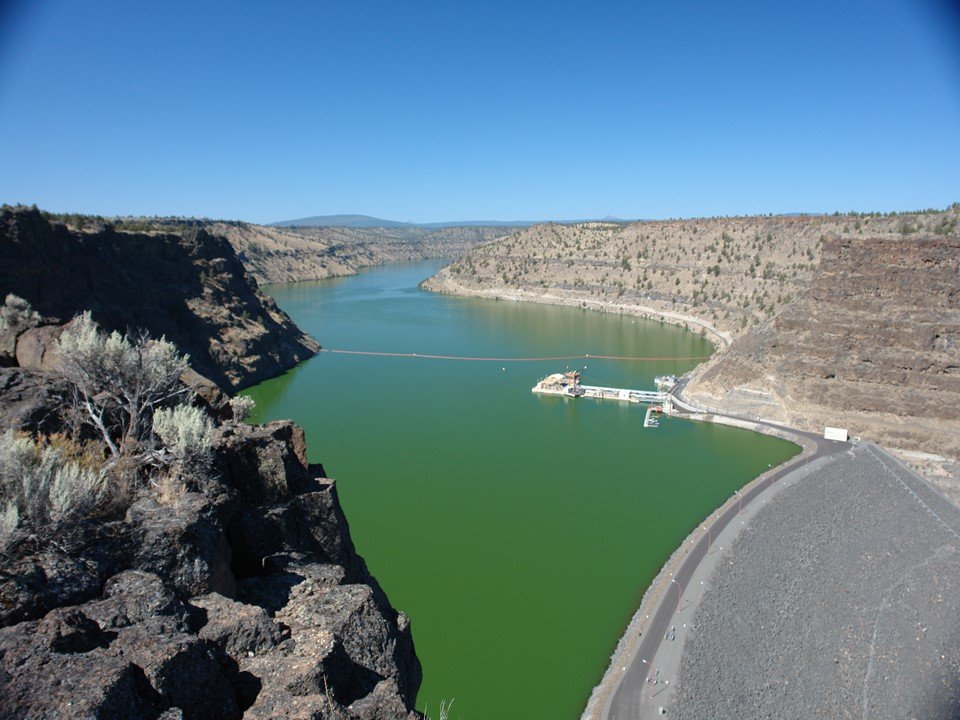River of Deceit
Blue green algae proliferates behind the concrete structure of the Pelton Dam. The selective water withdrawal tower (image center) has cost tax payers millions, while wrecking the lower Deschutes River water quality and impeding migrating steelhead and salmon.
Those who love the Deschutes are frustrated by Native Fish Society’s recommendations for a path forward, which appear to largely parrot the talking points that PGE has been making for the past decade.
A lot of eyebrows were raised a couple weeks ago when Native Fish Society reported on their role as members of Portland General Electric’s Fish Committee. Those who love the Deschutes are frustrated by NFS’s recommendations for a path forward, which appear to largely parrot the talking points the PGE has been making for the past decade.
The canards about the selective withdrawal tower (SWW) have proliferated like so much stalk diatom algae in the lower river. I still hear some people describe the contraption as a “fish tower,” and others still have misconstrued the SWW as an elevator that moves salmonids through the project like office workers through a skyscraper. Still others bear witness to the wisdom of the tower by claiming that it has restored “natural conditions” to the flow regime of the Deschutes. Apologists for the tower, including NFS, will tell you that it isn’t possible to positively affect temperatures in the lower river, due to federal regulations, and the need to conserve cold water so as to not run out of it in the fall. So the selective withdrawal tower, in terms of temperature management, is apparently not so selective, relegating the lower Deschutes to warmer, grossly more scummy water than what existed before the tower went operational in 2009. (More on that in a bit.)
“Selective withdrawal” is an apt description of a popular yet comically ineffective method of birth control that instead led to the conception of untold millions of children. Unfortunately, PGE’s selective withdrawal tower is just as awful. Like pulling out as a means of preventing pregnancy, the tower causes the opposite of its claimed benefit. Far from creating a healthier river, the tower has done, and continues to do, tremendous ecological damage. But the tower does seem to work as a contraceptive–for fish reproduction.
For most of the year, surface water from Lake Billy Chinook–warm, polluted water from the Crooked and Deschutes Rivers upstream of the dam–is now mainlined into the lower river.
The Oregon Department of Fish and Wildlife marks the yearly run of steelhead on the Deschutes from June 1st to May 31st of the following year. For the steelhead year just passed, PGE can crow about 124 steelhead that can be directly attributed to the reintroduction effort. At a cost to PGE shareholders of more than $100 million for the SWW, surely these 124 steelhead are some of the most expensive salmonids on the planet. Perversely, in January and February, PGE celebrated these 124 steelhead as a record in the annals of SWW fish production, a harbinger of the plenitude to come. All the evidence points another direction.
As the graph below illustrates,
Graph showing warmer water temperatures on the lower Deschutes River as a result of the introduction of the selective water withdrawal tower at Pelton Dam near Warm Springs, Oregon.
for the vast majority of the year, operation of the selective withdrawal tower has made the Deschutes warmer. Cooler than pre-tower water, which NFS and PGE claim is more in line with the “natural” historic flow the river, comes only for a few weeks in late summer and early fall. That point is debatable, but it's lost in the reality that for ten months out of the year the Deschutes is now warmer, save for those precious weeks in the fall, than it was before the tower began operations. This is especially bad in spring and early summer, when the Deschutes is now warmer, sometimes by several degrees, than the mainstem Columbia into which it empties. There is nothing natural about that, unless you consider the predilection of a large corporation to lie about its environmental record.
Just as importantly, the change in temperature is only half the story. Agricultural runoff– “nutrients” in the parlance of science–have skyrocketed with the start of tower operations. To understand this, you have to keep in mind that the selective withdrawal tower isn’t so selective.
For most of the year, surface water from Lake Billy Chinook–warm, polluted water from the Crooked and Deschutes Rivers upstream of the dam–is now mainlined into the lower river. Prior to tower operations, Round Butte Dam released 100 percent of the flow of the lower Deschutes from the bottom of the reservoir. This cold, and just as importantly, clean water made the Deschutes one of the best, if not the best, tailwater fisheries in the world. Beyond temperature issues, changes in water chemistry in the Deschutes are profound. The graph below shows a snapshot of the pH level in the river around Maupin last month. State standards for pH are violated when above 8.5. The lower Deschutes is now routinely in violation of this standard.
There’s a lot more to unpack here—including debunking PGE’s claims about the current flow regime being more “natural.” But let’s take it one bite sized chunk at a time.
Until next week.
If you enjoy what you’ve read, and you want to support my mission to remove dams throughout the US, please consider purchasing my latest book, Cracked: The Future of Dams in a Hot Chaotic World.
Once a week I write about critical issues that affect salmon, steelhead, and free flowing rivers throughout the west. Please subscribe to my newsletter below:


